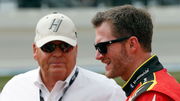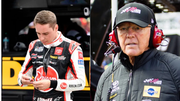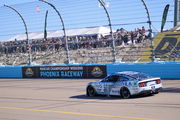
via Imago
Kyle Petty, Adam Petty

via Imago
Kyle Petty, Adam Petty
The Petty name is woven into the very fabric of NASCAR. From Lee Petty’s pioneering days to Richard Petty’s record-setting dominance with seven championships, the family has shaped the sport for generations. Kyle Petty carried that torch, not just as a driver but as a father determined to pass on the legacy. But raising the next Petty racer wasn’t just about putting his son Adam Petty in a car. It was about instilling knowledge, discipline, and a deep understanding of the craft. Kyle knew that Adam’s journey couldn’t be a handout. It had to be earned.
So, he did something bold. He walked away from an established Cup ride, built his own team, and took an unconventional path to ensure Adam was truly ready. The way he did it? That’s a story worth telling.
ADVERTISEMENT
Article continues below this ad
Kyle Petty’s bold move to shape Adam Petty’s racing career
“When I started, I worked at the race shop… I had to work in every department for one solid year… When Adam came along, it was like I need to give him that,” Kyle Petty said. Richard Petty, Kyle’s father, ensured that his son understood every aspect of the car before he ever started racing. So, for Kyle to do that, he needed to make some sacrifices.
Kyle Petty wasn’t just continuing a family tradition. He was building a new path. Instead of relying on an established team, he created Petty Enterprises 2 (PE2). “I had to give Adam a place to race. So I left Felix and started my own deal,” Kyle said on the Happy Hour with Kevin Harvick. Kyle had spent years racing for Felix Sabates’ SABCO Racing, a team he joined in 1989. Sabates had built SABCO into a competitive NASCAR outfit with drivers like Kyle, Sterling Marlin, and Joe Nemechek. Petty left this to give his son a better career, and once his son was on board, Adam started taking to it like a duck to water.
However, Kyle ensured that it was not all smooth sailing. Adam had to earn his ride and had to do it by understanding the car and how it works. Adam was eager to learn and spent a lot of time with his dad working on Late Models and testing cars before ever going to a race. A stark contrast to Kyle in his youth, who was just obsessed with racing. Kyle often joked with his dad, “Adam’s the son you never had,” recognizing his son’s singular focus. Kyle, on the other hand, was a bit ‘scattered,’ as per his admission.
Kyle made him learn the car inside and out. “I’d lock him in the trailer and change the spring,” Kyle said. Then, he would ask Adam, “OK, what did I change? Go run it and tell me what I changed. Can you adjust as a driver or do we need to work on the car? You tell me what you want to do.” This thorough hands-on experience shaped Adam’s ability to adapt and communicate adjustments. This is what made Adam Petty the promising young driver he was. The guidance from Kyle which stemmed from The King’s mentality instilled by Lee Petty’s will to succeed. Adam had it all.

What’s your perspective on:
Did Kyle Petty's bold move redefine legacy building in NASCAR, or was it a risky gamble?
Have an interesting take?
Adam’s entry into racing was unconventional. “His path was different… He never raced anything,” Kyle admitted. This was based on Kyle’s father, Richard ‘The King’ Petty’s philosophy. The King believed that there was no point in wasting time on subordinate things. “What kind of driver do you want to be? I want to be a Cup driver. Then let’s go to Cup,” Kyle said on Richard Petty’s mindset. Kyle quickly made his major league stock car debut at the age of 18 at Talladega Superspeedway with a ninth-place finish. This is the mantra that Kyle followed with Adam, but Adam did not go directly to the Cup Series because that’s not what he wanted to do.
Adam Petty worked his way up by winning races in Legends cars and Late Models. By 1998, he was racing in the ARCA series, winning at Charlotte in his debut. In 1999, he moved to the NASCAR Busch Series, scoring a pole at Texas. His rapid rise suggested he was following in the family’s legendary footsteps. With Kyle’s guidance and Petty Enterprises’ backing him, Adam was set for a bright future. Tragically, that future would be cut short far too soon.
ADVERTISEMENT
Article continues below this ad
Trending
A rising talent gone too soon
Adam Petty seemed destined to carry the legendary Petty name into the next generation of NASCAR. The great-grandson of Lee Petty, grandson of Richard Petty, and son of Kyle Petty, he had racing in his blood. But more than just a name, Adam had talent. By 1999, Adam was racing full-time in the NASCAR Busch Series (now Xfinity Series), driving the No. 45 car for Petty Enterprises. His infectious energy and charismatic personality made him a fan favorite. His path mirrored his father’s in many ways, but he was determined to make his mark.
Tragedy struck on May 12, 2000, during a practice session at New Hampshire Motor Speedway for an upcoming Busch Series race. While entering Turn 3, Adam’s throttle got stuck wide open, leaving him unable to slow down. His car slammed into the wall nearly head-on at over 130 mph. The force of the impact caused fatal basilar skull fractures, the same type of injury that would claim Dale Earnhardt Sr. just months later at Daytona. Adam was only 19 years old.
ADVERTISEMENT
Article continues below this ad
His death shook the NASCAR world and prompted serious discussions on safety. Shortly after, NASCAR mandated kill switches on steering wheels and later introduced the HANS (Head and Neck Safety) device, aimed at preventing similar fatal injuries. Though his career was cut short, Adam’s memory lives on. Not just in the Petty legacy but also in the Victory Junction Camp, a charity founded in his honor to support children with chronic illnesses, a passion that Adam had growing up.
ADVERTISEMENT
ADVERTISEMENT
ADVERTISEMENT
ADVERTISEMENT







Did Kyle Petty's bold move redefine legacy building in NASCAR, or was it a risky gamble?